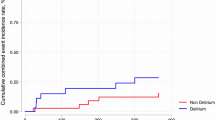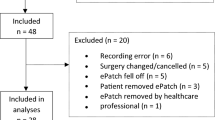Abstract
Measurement of heart rate variability (HRV) is useful in assessing the function of the autonomic nervous system and in staging of clinical diseases. The purpose of this study is to assess a feasibility of HRV for evaluating surgical stress during the noncardiac perioperative period. Standard deviation of normal-to-normal RR intervals (SDNN) and HRV triangular index derived from 24-h Holter ECC were measured in 24 patients undergoing digestive surgery. Holter ECG was performed at 1 day before operation, the first day (postoperative day 1: POD1), and the 7th day (POD7) after operation. Indices of HRV were compared with factors influencing surgical stress, such as duration of the operation and amount of blood loss during the operation, and postoperative complications. The SDNN and HRV triangular index decreased significantly on POD1 and recovered on POD7 (P < 0.05). Heart rate variability indices correlated significantly to duration and blood loss of operation (both P < 0.05). In 7 patients with postoperative complications, HRV indices were statistically lower than those in patients without complications on POD1 (P < 0.05). Our results indicate that HRV may provide useful information with respect to surgical stress.
Similar content being viewed by others
References
Lown B, Verrier RL (1976) Neural activity and ventricular fi brillation. N Engl J Med 294:1165–1170
Schwartz PJ, La Rovere MT, Vanoli E (1992) Autonomic nervous system and sudden cardiac death. Circulation 85(Suppl I):I-77–91
Camm AJ, Malik M, Bigger JT Jr (1996) Heart rate variability. Standards and measurement, physiological interpretation, and clinical use. Circulation 93:1043–1065
Stys A, Stys T (1998) Current clinical applications of heart rate variability. Clin Cardiol 21:719–724
Schneider RA, Castiloe JP (1965) Relationship of sinus arrhythmia to age and its prognostic signifi cance in ischemic heart disease. Clin Res 13:219
Kleiger RE, Miller JP, Bigger JT Jr, Moss AJ (1987) Decreased heart rate variability and its association with increased mortality after acute myocardial infarction. Am J Cardiol 59:256–262
Farrell TG, Bashir Y, Cripps T, Malik M, Poloniecki J, Bennett ED, Ward DE, Camm AJ (1991) Risk stratifi cation for arrhythmic events in postinfarction patients based on heart rate variability, ambulatory electrocardiographic indices and the signal-averaged electrocardiogram. J Am Coll Cardiol 18:687–697
Nolan J, Batin PD, Andrews R, Lindsay SJ, Brooksby P, Mullen M, Baig W, Flapan AD, Cowley A (1998) Prospective study of heart rate variability and mortality in chronic heart failure. Circulation 98:1510–1516
Pagani M, Malfatto G, Pierini S, Casati R, Masu AM, Poli M, Guzzetti S, Lombardi F, Cerutti S, Malliani A (1988) Spectral analysis of heart rate variability in the assessment of autonomic diabetic neuropathy. J Auton Nerv Syst 23:143–153
Bennett T, Farquhar IK, Hosking DJ, Hampton JR (1978) Assessment of methods for estimating autonomic nervous control of the heart in patients with diabetes mellitus. Diabetes 27:1167–1174
Hayano J, Takahashi H, Toriyama T, Mukai S, Okada A, Sakata S, Yamada A, Ohte N, Kawahara H (1999) Prognostic value of heart rate variability during long-term follow up in chronic haemodialysis patients with end-stage renal disease. Nephrol Dial Transplant 14:1480–1488
Norris PR, Morris JA Jr, Ozdas A, Grogan EL, Williams AE (2005) Heart rate variability predicts trauma patient outcome as early as 12 h: implications for military and civilian triage. J Surg Res 129: 122–128
Tasaki H, Serita T, Ueyama C, Kitano K, Seto S, Yano K (2006) Long-term follow-up of the circadian rhythm of heart rate and heart rate variability in healthy elderly patients. Circ J 70:889–895
Moriguchi T, Hirasawa H, Oda S, Tateishi Y (2004) Analysis of heart rate variability is a useful tool to predict the occurrence of septic shock in the patients with severe sepsis. Nippon Rinsho 62: 2285–2290
Seely AJ, Christou NV (2000) Multiple organ dysfunction syndrome: exploring the paradigm of complex nonlinear systems. Crit Care Med 28:2193–2200
Godin PJ, Buchman TG (1996) Uncoupling of biological oscillators: a complementary hypothesis concerning the pathogenesis of multiple organ dysfunction syndrome. Crit Care Med 24:1107–1116
Sakamoto K, Arakawa H, Mita S, Ishiko T, Ikei S, Egami H, Hisano S, Ogawa M (1994) Elevation of circulating interleukin 6 after surgery: factors influencing the serum level. Cytokine 6:181–186
Padova FDI, Pozzi C, Tondre MJ, Tritapepe R (1991) Selective and early increase of IL-1 inhibitors, IL-6 and cortisol after surgery. Clin Exp Immunol 85:137–142
Tokunaga A, Onda M, Fujita I, Okuda T, Mizutani T, Kiyama T, Matsukura N, Hunt TK (1993) Sequential changes in the cell mediators of peritoneal and wound fluids after surgery. Jpn J Surg 23:841–844
Lombardi F, Sandrone G, Pernpruner S, Sala R, Garimoldi M, Cerutti S, Baselli G, Pagani M, Malliani A (1987) Heart rate variability as an index of sympathovagal interaction after acute myocardial infarction. Am J Cardiol 60:1239–1245
Malik M, Farrell T, Cripps T, Camm AJ (1989) Heart rate variability in relation to prognosis after myocardial infarction: selection of optimal processing techniques. Eur Heart J 10:1060–1074
Malik M, Farrell T, Camm AJ (1990) Circadian rhythm of heart rate variability after acute myocardial infarction-influence on the prognostic value of heart rate variability. Am J Cardiol 66: 1049–1054
Odemuyiwa O, Malik M, Farrell T, Bashir Y, Poloniecki J, Camm J (1991) Comparison of the predictive characteristics of heart rate variability index and left ventricular ejection fraction for all-cause mortality, arrhythmic events and sudden death after acute myocardial infarction. Am J Cardiol 68:434–439
Sands KEF, Appel ML, Lilly LS, Schoen FJ, Mudge GH Jr, Cohen RJ (1989) Power spectrum analysis of heart rate variability in human cardiac transplant recipients. Circulation 79:76–82
Bigger JT Jr, Fleiss JL, Steinman RC, Rolnitzky LM, Kleiger RE, Rottman JN (1992) Frequency domain measures of heart period variability and mortality after myocardial infarction. Circulation 85:164–171
Onimaru S, Nakamura K, Kariyazono H, Ikeda R, Ueno T, Fukumoto Y, Yabuki A, Sakata R, Yamada K (2006) Inhibitory effects of edaravone on the production of tumor necrosis factor-á in the isolated heart undergoing ischemia and reperfusion. Heart Vessels 21:108–115
Blalock JE (1989) A molecular basis for bi-directional communication between the immune and neuroendocrine system. Physiol Rev 69:1–32
Author information
Authors and Affiliations
Corresponding author
Rights and permissions
About this article
Cite this article
Ushiyama, T., Mizushige, K., Wakabayashi, H. et al. Analysis of heart rate variability as an index of noncardiac surgical stress. Heart Vessels 23, 53–59 (2008). https://doi.org/10.1007/s00380-007-0997-6
Received:
Accepted:
Published:
Issue Date:
DOI: https://doi.org/10.1007/s00380-007-0997-6




